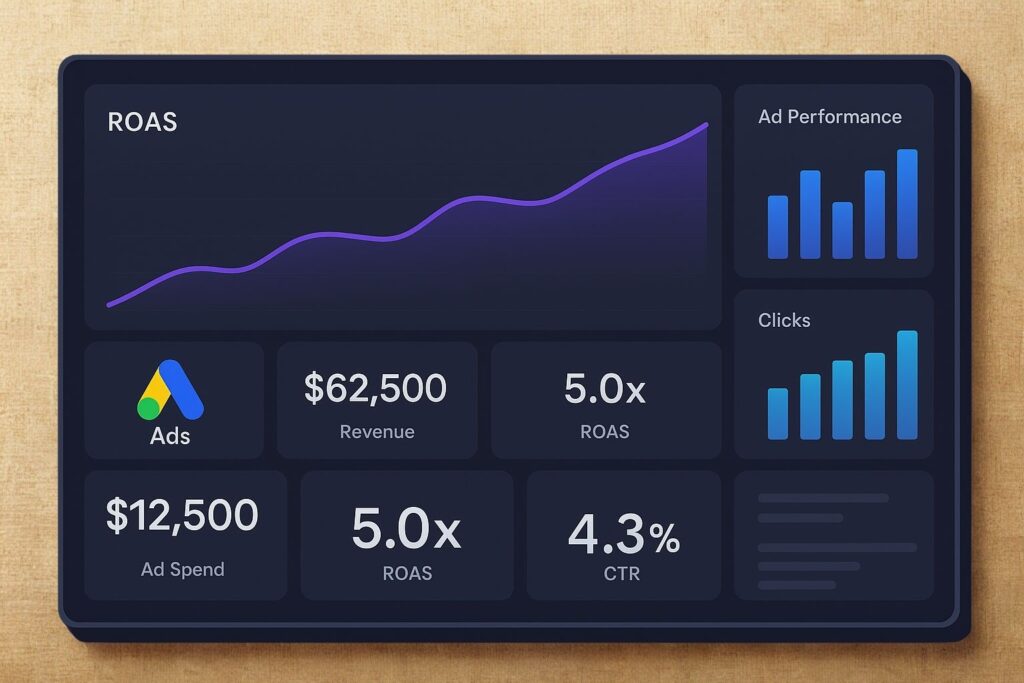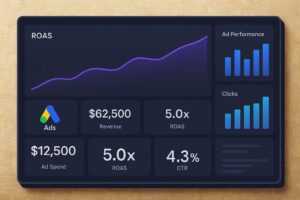
What if you could 3x your ad spend and still keep your ROAS intact—or better yet, improve it?
That’s not a fantasy. It’s the result of precision scaling and strategic ROAS Optimization. Whether you’re spending $100/day or $10,000/day, understanding how to scale without breaking your return is what separates high-performing e-commerce brands from the rest. In this blog, we’ll peel back the curtain on the exact budget-scaling strategies the smartest DTC brands are using in 2025 to stay ahead. Let’s turn your ad account into a scalable, ROAS-positive machine.
Introduction: Why ROAS Dies Without Strategy
Return on Ad Spend (ROAS) is a sacred metric in the performance marketing universe. But here’s the bitter truth—most brands see their ROAS crash the moment they scale budgets. Why? Because budget scaling without tactical strategy is like pressing the gas pedal with no GPS—you’ll go faster, but probably in the wrong direction. This post is your GPS.
1. Understand the ROAS Sweet Spot Before Scaling
Before increasing spend, identify your current ROAS benchmarks—your breakeven ROAS, profitable ROAS, and historical performance at different budget levels.
Tip: Use data segmentation in Google Ads or Meta Ads Manager to find performance trends by day, audience, placement, and creative.
2. Vertical vs. Horizontal Scaling—Which Wins?
- Vertical scaling means increasing the budget of your best-performing campaigns.
- Horizontal scaling means duplicating and testing campaigns across new audiences, geographies, or creative variations.
Pro Tip: Start with horizontal to validate breadth. Use vertical only on high-performing ad sets with consistent cost per result.
3. Use Campaign Budget Optimization (CBO) Smartly
Meta’s CBO and Google’s Performance Max can efficiently allocate spend—but only when your ad sets and creative are properly diversified.
Optimization Tip: Group ad sets by similar funnel stages and intent. Avoid mixing cold and warm audiences under one campaign if you want to control spend efficiently.
4. Implement Breakpoint Budget Increases
Scaling doesn’t mean doubling budgets overnight. Follow the 20-30% rule—increase budgets gradually (no more than 20-30% every 48-72 hours) to avoid algorithmic shock.
Real Example: A Shopify DTC brand increased its budget from $1,000 to $2,000 over 7 days with no drop in ROAS, thanks to incremental scaling + creative refresh.
5. ROAS-Boosting Creative Rotation
As you scale, creative fatigue becomes the silent killer. A high-ROAS ad today could drain your spend tomorrow.
Creative Rule of Thumb: For every 1X increase in budget, plan at least 2-3 new creatives.
Use dynamic ads or UGC to maintain engagement.
6. Use Automation Rules to Maintain ROAS
Set rules inside Google and Meta Ads to automatically pause ad sets that fall below your ROAS threshold and boost ones that exceed it.
Suggested Rule:
“If ROAS < 1.5 for 2 days → pause ad set”
“If ROAS > 3 for 3 days → increase budget 20%”
7. Consolidate High-Intent Audiences for Scaling
At scale, precision matters. Retargeting and lookalike audiences typically drive stronger ROAS than broad, cold traffic.
Power Tip:
Layer audiences with behaviour-based triggers (e.g., “Added to Cart + Engaged with Ads in last 7 days”).
8. Measure ROAS in the Right Context
Sometimes ROAS looks like it’s dropping—but CAC (Customer Acquisition Cost) is stable or even improving. That’s why you need to track ROAS alongside other metrics like:
- MER (Marketing Efficiency Ratio)
- LTV (Lifetime Value)
- CAC Payback Window
Conclusion: Scale Smarter, Not Just Bigger
The brands that win in 2025 won’t be the ones who spend the most—it will be the ones who spend the smartest. Budget scaling without a ROAS-centric strategy is just a fast track to wasted spending. But with the techniques you’ve just read—from creative rotation to automation rules—you’re no longer guessing. You’re scaling with confidence.
Take Action:
Audit your current scaling strategy. Identify one high-performing ad set today, and apply the 20% budget increase + fresh creative rule. Track the results over the next 3 days.
Want help implementing a ROAS-focused scaling strategy?
Book a free performance audit, and let’s unlock your ad potential.
- The Power of UTM Parameters in Ad Campaigns
- Unlocking Maximum ROAS: Budget Scaling Secrets for 2025
- How to Use A/B Testing to Scale Paid Ad Performance
- Click-Through Rate (CTR) Hacks That Actually Work
- Meta Ads Funnel Strategies for Customer Acquisition
- Google Performance Max: Winning Strategies for E-commerce
- Performance Marketing Playbook: A No-Fluff Guide to Winning in 2025
- Mastering Customer Experience & Retention on Shopify
- Best Shopify Apps to Skyrocket Your E-commerce Growth










